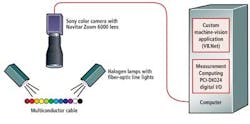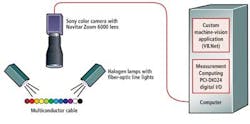COLOR INSPECTION: Smart system uses statistical analysis to check cable colors
Determining the color of objects and whether they match specific criteria is important in many manufacturing sectors, including cable manufacturing and assembly. In producing multiconductor colored cables, for example, manufacturers must ensure that the colored cables are placed in the correct order and whether enough epoxy has been applied to form a firm bond.
Keox Technologies (http://keoxtech.com), a multidisciplinary engineering company, was tasked to automate this process for a large cable manufacturing company.
"In the production of multiconductor cables," says Daniel Ma, president of Keox, "the company needed to ensure that cables consisting of up to 12 multicolored wires were in the proper order and properly attached. Since these cables are manufactured in lengths of up to a few kilometers, any defects that may occur in the assembly process will prove to be extremely costly."
To produce the cables, an operator first feeds each colored wire into custom-built wire guides to ensure that they are kept in order as they move into the epoxy bonding station. However, since these cables are assembled at the rate of 5 m/sec, they may jump from the custom wire guides, resulting in a color cable assembly built in the incorrect order.
Keox was not the first company that was approached to solve this problem. Previously, the cable manufacturer had deployed smart RGB cameras to perform color inspection. After computing the histogram of the RGB values, it was first thought that by setting a simple threshold each color cable could be correctly identified.
"Unfortunately," says Ma, "the manufacturer was not responsible for the process control of the coloring of the cables, and this approach resulted in red wires being detected as brown and purple wires as blue, for example." To overcome the numerous false positive and false negative errors, Keox designed and built an online inspection system for the cable to pass through during production.
A progressive-scan color FireWire camera from Sony Electronics (www.sony.com/video cameras) affixed with a Zoom 6000 lens from Navitar (www.navitar.com) is used to image a 30-mm field of view (FOV) of the cable as it moves through the custom assembly (see figure). Two halogen lamps are placed at 45° angles to the FOV of the camera-to illuminate void defects.
Images taken at 0.5-sec intervals are then transferred to a host PC for processing. A nearest-neighbor clustering approach using Mahalanobis distance as the objective function gives a correlation between R, G, and B because of a covariance matrix calculation, as opposed to using Euclidean distance.
"By finding the center of mass of the sample dataset and the Euclidean distance between this center of mass and the test object, the system can determine the color of the object," says Ma. "However, this approach does not take into account that the sample points may not be distributed around the center of mass in a spherical manner."
This is illustrated by Rick Winklin in his article "What is Mahalanobis distance?" that can be found at http://bit.ly/wXvSD0.
"By taking this into account," says Ma, "the color of any specific cable can be more accurately classified." As each cable is assembled, each of the cable colors is determined. Should any cable be incorrect, the PC uses an embedded TTL I/O board from Measurement Computing (www.mccdaq.com) to trigger a programmable logic controller (PLC) that halts the assembly process. Captured images can be reviewed by the operator for further analysis.
According to Ma, the inspection system caught a production error of switched-order wires within a few hours of being deployed, saving the cable manufacturer almost $10,000 on one production run. The inspection system was also used as a process understanding tool. "Previously," says Ma, "process engineers always suspected that the wires would actually jump in and out of order through their wire guides during production. However, this was never proven because it was not practical to scrutinize large spools of cable. With the online inspection system, images of this occurrence could be validated."
Vision Systems Articles Archives

